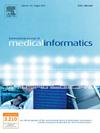Deep learning and machine learning in CT-based COPD diagnosis: Systematic review and meta-analysis
IF 3.7
2区 医学
Q2 COMPUTER SCIENCE, INFORMATION SYSTEMS
International Journal of Medical Informatics
Pub Date : 2025-01-30
DOI:10.1016/j.ijmedinf.2025.105812
引用次数: 0
Abstract
Background
With advancements in medical technology and science, chronic obstructive pulmonary disease (COPD), one of the world’s three major chronic diseases, has seen numerous remarkable outcomes when combined with artificial intelligence, particularly in disease diagnosis. However, the diagnostic performance of these AI models still lacks comprehensive evidence. Therefore, this study quantitatively analyzed the diagnostic performance of AI models in CT images of COPD patients, aiming to promote the development of related research in the future.
Methods
PubMed, Cochrane Library, Web of Science, and Embase were retrieved up to September 1, 2024. The QUADAS-2 evaluation tool was used to assess the quality of the included studies. Meta-analysis of the included researches was performed using Stata18, RevMan 5.4, and Meta-Disc 1.4 software to merge sensitivity, specificity and plot a summary receiver operating characteristic curve (SROC). Heterogeneity was assessed using the Q statistic, and sources of inter-study heterogeneity were explored through meta-regression analysis.
Results
Twenty-two of 3280 identified studies were eligible. Meta-analysis was performed on 15 of these studies, encompassing a total of 22,817 patients for which statistical metrics were reported or could be calculated. Seven studies were based on deep learning (DL) model, three on machine learning (ML) model, and five on DL model with multiple-instance learning (MIL) mechanisms. One study evaluated both DL and ML models. The meta-analysis results showed that the pooled sensitivity of all DL and ML models was 86 % (95 %CI 78–91 %), specificity was 87 % (95 %CI 83–91 %), and area under the curve was 93 % (95 %CI 90–95 %). Subgroup analyses revealed no significant difference in diagnostic sensitivity and specificity between DL and ML models (sensitivity 82 % (95 %CI 76–87 %), 93 % (95 %CI 85–97 %); specificity 87 % (95 %CI 79–91 %), 84 % (95 %CI 79–88 %), and the DL model with MIL (sensitivity 87 % (95 %CI 61–96 %); specificity 89 % (95 %CI 78–95 %) improved the performance of DL model, but this improvement was not statistically significant (p > 0.05).
Conclusion
Both DL and ML models for diagnosing COPD using CT images exhibited high accuracy. There was no significant difference in diagnostic efficacy between the two types of AI models, and the addition of the MIL mechanism may enhance the performance of the DL model.
基于ct的COPD诊断中的深度学习和机器学习:系统回顾和荟萃分析。
背景:随着医学技术和科学的进步,慢性阻塞性肺疾病(COPD)作为世界三大慢性疾病之一,与人工智能相结合取得了许多显著的成果,特别是在疾病诊断方面。然而,这些人工智能模型的诊断性能仍然缺乏全面的证据。因此,本研究定量分析AI模型在COPD患者CT图像中的诊断性能,旨在促进未来相关研究的发展。方法:检索截止到2024年9月1日的PubMed、Cochrane Library、Web of Science和Embase。采用QUADAS-2评价工具评价纳入研究的质量。采用Stata18、RevMan 5.4和Meta-Disc 1.4软件对纳入的研究进行meta分析,合并敏感性、特异性并绘制汇总的受试者工作特征曲线(SROC)。采用Q统计量评估异质性,并通过meta回归分析探讨研究间异质性的来源。结果:3280项研究中有22项符合条件。对其中15项研究进行了荟萃分析,共纳入了22,817例已报告或可计算统计指标的患者。7项研究基于深度学习(DL)模型,3项研究基于机器学习(ML)模型,5项研究基于多实例学习(MIL)机制的深度学习模型。一项研究同时评估DL和ML模型。meta分析结果显示,所有DL和ML模型的总敏感性为86% (95% CI 78 ~ 91%),特异性为87% (95% CI 83 ~ 91%),曲线下面积为93% (95% CI 90 ~ 95%)。亚组分析显示DL和ML模型的诊断敏感性和特异性无显著差异(敏感性分别为82% (95% CI 76- 87%)和93% (95% CI 85- 97%);特异性为87% (95% CI 79- 91%), 84% (95% CI 79- 88%),与MIL的DL模型(敏感性87% (95% CI 61- 96%);特异性为89% (95% CI 78 ~ 95%),改善DL模型的性能,但无统计学意义(p < 0.05)。结论:DL和ML模型对慢性阻塞性肺病的CT影像诊断均具有较高的准确性。两种AI模型的诊断效能无显著差异,MIL机制的加入可能会增强DL模型的性能。
本文章由计算机程序翻译,如有差异,请以英文原文为准。
求助全文
约1分钟内获得全文
求助全文
来源期刊

International Journal of Medical Informatics
医学-计算机:信息系统
CiteScore
8.90
自引率
4.10%
发文量
217
审稿时长
42 days
期刊介绍:
International Journal of Medical Informatics provides an international medium for dissemination of original results and interpretative reviews concerning the field of medical informatics. The Journal emphasizes the evaluation of systems in healthcare settings.
The scope of journal covers:
Information systems, including national or international registration systems, hospital information systems, departmental and/or physician''s office systems, document handling systems, electronic medical record systems, standardization, systems integration etc.;
Computer-aided medical decision support systems using heuristic, algorithmic and/or statistical methods as exemplified in decision theory, protocol development, artificial intelligence, etc.
Educational computer based programs pertaining to medical informatics or medicine in general;
Organizational, economic, social, clinical impact, ethical and cost-benefit aspects of IT applications in health care.
 求助内容:
求助内容: 应助结果提醒方式:
应助结果提醒方式:


